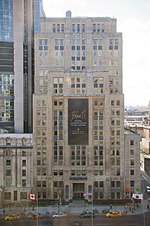Hospital for Sick Children (Toronto)
1875 establishments in OntarioCertified airports in OntarioChildren's hospitals in CanadaHarv and Sfn no-target errorsHeliports in Ontario ... and 4 more
Hospital buildings completed in 1891Hospitals affiliated with the University of TorontoHospitals established in 1875Hospitals in Toronto

The Hospital for Sick Children (HSC), corporately branded as SickKids, is a major pediatric teaching hospital located on University Avenue in Toronto, Ontario, Canada. Affiliated with the Faculty of Medicine of the University of Toronto, the hospital was ranked the top pediatric hospital in the world by Newsweek in 2021.The hospital's Peter Gilgan Centre for Research and Learning is believed to be the largest pediatric research tower in the world, at 69,677.28 square metres (750,000.0 sq ft).
Excerpt from the Wikipedia article Hospital for Sick Children (Toronto) (License: CC BY-SA 3.0, Authors, Images).Hospital for Sick Children (Toronto)
University Avenue, Old Toronto
Geographical coordinates (GPS) Address Nearby Places Show on map
Geographical coordinates (GPS)
| Latitude | Longitude |
|---|---|
| N 43.6571 ° | E -79.3885 ° |
Address
University Avenue 555
M5G 1X3 Old Toronto
Ontario, Canada
Open on Google Maps







